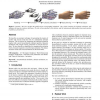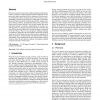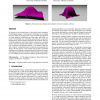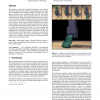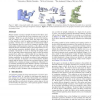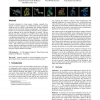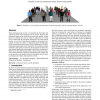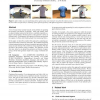TOG
2008
13 years 11 months ago
2008
We describe an automatic technique for generating the motion of tendons and muscles under the skin of a traditionally animated character. This is achieved by integrating the tradi...
TOG
2008
13 years 11 months ago
2008
Previous research has shown that a global multiple scattering simulation is needed to achieve physically realistic renderings of hair, particularly light-colored hair with low abs...
TOG
2008
13 years 11 months ago
2008
We present a new discretization for the physics-based animation of developable surfaces. Constrained to not deform at all in-plane but free to bend out-of-plane, these are an exce...
TOG
2008
13 years 11 months ago
2008
We introduce a method for efficiently animating a wide range of deformable materials. We combine a high resolution surface mesh with a tetrahedral finite element simulator that ma...
TOG
2008
13 years 11 months ago
2008
Animating natural human motion in dynamic environments is difficult because of complex geometric and physical interactions. Simulation provides an automatic solution to parts of t...
TOG
2008
13 years 11 months ago
2008
Humans usually associate an upright orientation with objects, placing them in a way that they are most commonly seen in our surroundings. While it is an open challenge to recover ...
TOG
2008
13 years 11 months ago
2008
Character animation in video games--whether manually keyframed or motion captured--has traditionally relied on codifying skeletons early in a game's development, and creating...
TOG
2008
13 years 11 months ago
2008
When simulating large crowds, it is inevitable that the models and motions of many virtual characters will be cloned. However, the perceptual impact of this trade-off has never be...
TOG
2008
13 years 11 months ago
2008
A lot of research has recently focused on the problem of capturing the geometry and motion of garments. Such work usually relies on special markers printed on the fabric to establ...
TOG
2008
13 years 11 months ago
2008
